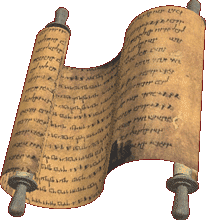|
Christian Doctrine
As churches grew, Christians began to ask questions about their faith. What exactly did Jesus say? Is it necessary for Christian gentiles to be circumcised? How should the Lord’s Supper be celebrated? How are church leaders to be chosen? What should be done about sin?
While the apostles were living, these questions were generally referred to them.
The apostles were always willing to teach, and to tell about the acts and words of Jesus, but as they died, a need arose for a more permanent record of their teachings.
Compiling the Bible Record
 An obvious collection of writings to be included in the Christian Bible were the Old Testament manuscripts. By the end of the 1st century, the contents of the Old Testament were fixed as including the 39 books which we now have. A few others, known as the Deuterocanonical books, were accepted by some just as they are now accepted as a lesser authority by some Christian churches today. An obvious collection of writings to be included in the Christian Bible were the Old Testament manuscripts. By the end of the 1st century, the contents of the Old Testament were fixed as including the 39 books which we now have. A few others, known as the Deuterocanonical books, were accepted by some just as they are now accepted as a lesser authority by some Christian churches today.
As for the more recent writings, there was wide support for the inclusion of Paul’s letters and the four Gospels. Written by apostles, they represented a firsthand knowledge of the acts and words of Christ. Other writings were more controversial, with arguments over the letters of Jude, John, and Peter. Hebrews, James, and Revelation also required discussion. Some churches thought that other writings, such as The Shepherd of Hermas and the Letter of Barnabas, should be included, but eventually they settled on the New Testament as we know it today. We have no record of it before AD 369, but it represents a consensus of the writings whose authority stood out from the rest, that which had proven to clarify the doctrines of the church.
Threats to Basic Beliefs
The leaders of the Christian church saw a great need for a consensus on the books that make up Christian doctrine, as unorthodox beliefs were competing with orthodox faith.
The Gnostics, for example, rejected the Old Testament, claiming secret knowledge of God, humanity, and the rest of the universe of which the general Christian community was unaware, and which was only loosely based on accepted Scripture.
Another threat to orthodox Christianity came from Marcion, the son of a bishop. Marcion regarded the created world as evil. He rejected the Old Testament writings altogether, along with those New Testament writings that linked the New Testament promises with the God of Old Testament law. He reduced the words of the apostles to those which spoke only of the God of love, and the God of salvation. In some ways, the New Age teachings of today resemble that of Marcion.
Creeds and Councils
Over the years, statements began to emerge summing up the basic tenets of Christianity. In time, the early leaders of the church added to, modified, or explained these statements of faith.
Irenaeus
Irenaeus came from Lyons in Gaul, which is present-day France. He spent much of his time defending the faith against such heresies as Gnosticism. He was careful always to base his arguments in Bible teaching, illuminating the core beliefs of the church.
|
